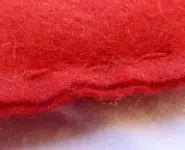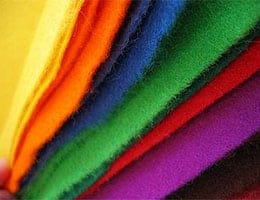 The concept of felt , which comes from the Germanic language, refers to a textile product that is not woven , but is formed from the conglomeration of hair, wool or other material . Felt is a cloth that is used in various ways.
The concept of felt , which comes from the Germanic language, refers to a textile product that is not woven , but is formed from the conglomeration of hair, wool or other material . Felt is a cloth that is used in various ways.
Most textile products are woven: they are made by crossing longitudinal threads (the warp) with transverse threads (the weft). For weaving to be possible, therefore, the fibers must first be converted into threads.
Felt, on the other hand, is not a fabric . It is an element made from the union of fibers by a mechanical and thermal procedure , using steam or heat and generating pressure. The result is a homogeneous, flexible and porous sheet that stands out for its softness, elasticity and absorption capacity.
Generally, a lining or coating is added to felt. In this way, its structure improves, it is more resistant and can even become waterproof. Thus, reinforced felt is used in the manufacture of rugs, hats, skirts and other products.
It should be noted that felt is often mentioned as the first textile material developed by humans . It is believed that its discovery could be linked to the tufts of wool that the sheep left attached to the trees, which became matted. Another theory indicates that prehistoric man, when using garments made from fleece, ended up discovering that the humidity of sweat allowed for a compact material.
It is important to note that there are several types of felt, each of them with different characteristics and uses. For example, acrylic felt is ideal for use in making costumes, ornaments or a wide variety of crafts. Some of the fields in which it is used are the manufacture of toys, artificial flowers, costume jewelry and upholstery. It is possible to buy it in sheets of different colors and sizes. It is made entirely of polyester, it can be machine washed and ironed without problems.
On the other hand, we have acrylic adhesive felt , which is usually used to protect less resistant or delicate surfaces against friction, as occurs with parquet. Another application is the damping of electrical devices whose operation makes them vibrate.
 Synthetic felt , for its part, is also offered in many colors and is easy to manipulate: it can be cut, sewn and glued to create various products . There is also wool felt , which comes from the material that gives it its name and that is why it is very soft to the touch. It has many interesting properties, such as thermal protection, great flexibility and the fact that it is a good shock absorber and antistatic. Among its applications we can highlight the lining of pool tables, the production of hats and decorative items.
Synthetic felt , for its part, is also offered in many colors and is easy to manipulate: it can be cut, sewn and glued to create various products . There is also wool felt , which comes from the material that gives it its name and that is why it is very soft to the touch. It has many interesting properties, such as thermal protection, great flexibility and the fact that it is a good shock absorber and antistatic. Among its applications we can highlight the lining of pool tables, the production of hats and decorative items.
For tasks such as soundproofing, manufacturing musical instruments , and absorbing liquids, industrial felt is used, which is sold in larger pieces than others. Within this category we can find several materials, each one for a series of different applications.
Among the most general features of felt are the following: it is insulating; it is antistatic; It has good flexibility and cushions impacts; lasts a long time before deteriorating; offers a good degree of manipulation; Effectively protects against low temperatures and noise.
Regarding the manipulation possibilities that felt offers, we cite the following: we can fold it, cut it, iron it, stamp it, staple it, sew it, die-cut it and glue it with ease. Other advantages are that its edges are not prone to wrinkles, that it does not fray and that it does not need to be washed very frequently.
